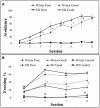A Window on the Study of Aversive Instrumental Learning: Strains, Performance, Neuroendocrine, and Immunologic Systems
- PMID: 27605910
- PMCID: PMC4995215
- DOI: 10.3389/fnbeh.2016.00162
A Window on the Study of Aversive Instrumental Learning: Strains, Performance, Neuroendocrine, and Immunologic Systems
Abstract
The avoidance response is present in pathological anxiety and interferes with normal daily functions. The aim of this article is to shed light on performance markers of active avoidance (AA) using two different rat strains, Sprague-Dawley (SD) and Wistar. Specifically, good and poor performers were evaluated regarding anxiety traits exhibited in the elevated plus maze (EPM) and corticosterone levels and motor activity in the open field test. In addition, the plasma levels of Interleukin-6 (IL-6), Interleukin-1Beta (IL-1beta), Nerve Growth Factor Beta (NGF-beta), Tumor Necrosis Factor-Alpha (TNF-alpha) and cytokine-induced neutrophil chemoattractant 1 (CINC-1) were compared in the good and poor performers to better understand the role of the immunologic system in aversive learning. Behavioral criteria were employed to identify subpopulations of SD and Wistar rats based on their behavioral scores during a two-way AA test. The animals were tested for anxiety-like behavior in the EPM and motor activity in the open-field test. Plasma corticosterone levels were measured at the end of the avoidance test. Cytokine levels of IL-6, IL-1beta, NGF-beta, TNF-alpha, and CINC-1 were measured in the plasma of the Wistar rats. Sixty-six percent of the Wistar rats and 35% of the SD rats exhibited a poor performance. This feature was associated with a decrease in anxiety-like behavior in the EPM. The poor and good performers exhibited lower levels of corticosterone compared with the control animals, which suggests that training alters corticosterone levels, thereby leading to hypocortisolism, independent of the performance. The CINC-1 levels were increased in the poor performers, which reinforces the role of immunologic system activation in learning deficits. Our study provides a better understanding of the complex interactions that underlie neuroimmune consequences and their implications for performance.
Keywords: anxiety; aversive instrumental learning; avoidance; corticosterone; elevated plus-maze; immunologic system.
Figures





Similar articles
-
The dorsal periaqueductal gray modulates the increased fear-like behavior exhibited by experienced rats in the elevated plus-maze.Behav Brain Res. 2010 Jan 5;206(1):120-6. doi: 10.1016/j.bbr.2009.09.001. Epub 2009 Sep 6. Behav Brain Res. 2010. PMID: 19737580
-
Cytokine mRNA levels in brain and peripheral tissues of the rat: relationships with plus-maze behavior.Brain Res Mol Brain Res. 2005 Jun 13;137(1-2):159-65. doi: 10.1016/j.molbrainres.2005.03.002. Epub 2005 Apr 12. Brain Res Mol Brain Res. 2005. PMID: 15950774
-
Anxiolytic effects of yokukansan, a traditional Japanese medicine, via serotonin 5-HT1A receptors on anxiety-related behaviors in rats experienced aversive stress.J Ethnopharmacol. 2012 Sep 28;143(2):533-9. doi: 10.1016/j.jep.2012.07.007. Epub 2012 Jul 20. J Ethnopharmacol. 2012. PMID: 22819689
-
Relationship between striatal levels of interleukin-2 mRNA and plus-maze behaviour in the rat.Neurosci Lett. 2003 May 8;341(3):205-8. doi: 10.1016/s0304-3940(03)00184-8. Neurosci Lett. 2003. PMID: 12697284
-
Acute and long-term consequences of single MDMA administration in relation to individual anxiety levels in the rat.Behav Brain Res. 2004 Mar 2;149(2):135-44. doi: 10.1016/s0166-4328(03)00220-1. Behav Brain Res. 2004. PMID: 15129777
Cited by
-
Unravelling the Role of Habenula Subnuclei on Avoidance Response: Focus on Activation and Neuroinflammation.Int J Mol Sci. 2023 Jun 27;24(13):10693. doi: 10.3390/ijms241310693. Int J Mol Sci. 2023. PMID: 37445871 Free PMC article.
-
Dopamine modulates individual differences in avoidance behavior: A pharmacological, immunohistochemical, neurochemical and volumetric investigation.Neurobiol Stress. 2020 Apr 8;12:100219. doi: 10.1016/j.ynstr.2020.100219. eCollection 2020 May. Neurobiol Stress. 2020. PMID: 32435668 Free PMC article.
-
Neuroinflammation in the prefrontal-amygdala-hippocampus network is associated with maladaptive avoidance behaviour.Heliyon. 2024 Apr 26;10(9):e30427. doi: 10.1016/j.heliyon.2024.e30427. eCollection 2024 May 15. Heliyon. 2024. PMID: 38694029 Free PMC article.
References
-
- American Psychiatric Association (2013). Diagnostic and Statistical Manual of Mental Disorders, 5th Edn. Arlington, VA: American Psychiatric Publishing.
-
- Ballendine S. A., Greba Q., Dawicki W., Zhang X., Gordon J. R., Howland J. G. (2015). Behavioral alterations in rat offspring following maternal immune activation and ELR-CXC chemokine receptor antagonism during pregnancy: implications for neurodevelopmental psychiatric disorders. Prog. Neuropsychopharmacol. Biol. Psychiatry 57, 155–165. 10.1016/j.pnpbp.2014.11.002 - DOI - PMC - PubMed
LinkOut - more resources
Full Text Sources
Other Literature Sources

